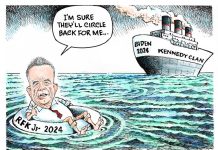American history is full of consequences in our lives and the lives of communities that can still be felt today — for good and bad.
It can be eye-opening when people learn about little-known bits of history that to this day have had some of the most pronounced and enduring ramifications.
The United Way of Bartholomew County provided some of that history to a group of a couple of dozen participants last week, hosting a Racial Wealth Gap Simulation.
The Republic’s Brian Blair covered the event and wrote about what several participants had to say at the end, when asked for a one-word reaction to what they had learned. This is what some participants said: “Angry. Embarrassed. Disgusted. Hopeless.”
“Part of that shocking effect was that participants said they never fully realized that a host of federal laws dating back as far as President Andrew Johnson’s land policies and sharecropping from 1865 to 1880 have put America’s Black residents at a distinct financial disadvantage compared to whites,” Blair wrote.
Lest anyone dismiss these examples as remnants of dusty history, our recent years are replete with examples of racist government policies.
“Redlining” was standard practice up until about 50 years ago. It takes its name from financial institutions that literally drew red lines on maps to mark predominantly Black and minority neighborhoods where they refused to write mortgages.
A generation before that, Black service members integrated the US Armed Forces, but when they returned home from World War II, many of the promises of the GI Bill — including easy home loans — were not available to them.
So in these contexts and many others, Black and minority Americans live with a legacy of systemic racism that white Americans have never experienced. This is undeniable in any conversation about economic justice and economic opportunity.
That is what the United Way facilitated last week — a conversation, and an opportunity for a diverse group of community members to learn. Discomforting as it may be, racial discrimination was official policy of the United States government long after slavery was abolished, and those policies cast very long shadows that can still be felt.
When greater numbers of people understand the past, and how it affects the present, it casts the wealth gap between white and Black Americans in a different light. Especially when you consider that for most of us, owning a home is the single largest driver of wealth.
For many Black and minority Americans, the playing field simply has never been level. As Blair reported, whites are more than three times as likely as Blacks to be homeowners in Columbus.
Problems like these have no easy answers. But learning from our past is fundamental if we truly want a more just and equitable future for all Americans. And the United Way provided a real service in helping our community take steps forward by first learning from the lingering inequities of the past.
If we are willing to take those lessons and learn from them, it bodes well for everyone going forward.
“We’re all here to learn,” Chris Price, chairman of United Way’s agency investment committee said. “And to deepen our overall understanding.”




